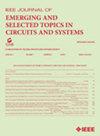多层叠结构的热透视设计与分析
IF 3.8
2区 工程技术
Q2 ENGINEERING, ELECTRICAL & ELECTRONIC
IEEE Journal on Emerging and Selected Topics in Circuits and Systems
Pub Date : 2025-07-21
DOI:10.1109/JETCAS.2025.3590877
引用次数: 0
摘要
本文采用有限元分析方法研究了多层金属互连体在三维堆叠结构中的热性能。3D集成电路(3D IC)由五个垂直堆叠的芯片组成。芯片之间的互连是通过硅通孔(tsv)、金属再分配层(rdl)和混合键合实现的。由于三维集成电路结构的复杂性,本工作通过对每个芯片层和混合键合结构采用等效模型来简化详细的三维集成电路模型。研究表明,Cu的含量对杂化键合结构的导热系数有显著影响,表现为准线性关系。此外,上下铜衬垫之间的错位降低了结构的导热性。在此基础上,结合具体案例构建了金属互连层和tsv等不同芯片层的等效模型,并提取了等效导热系数。基于各层的等效结果,最终确定了复杂三维集成电路结构的导热系数。本工作对三维集成电路的热设计和实践具有重要的指导意义。本文章由计算机程序翻译,如有差异,请以英文原文为准。
Thermal Perspective Design and Analysis of Multi-Stacked Structures
This paper investigates the thermal performance of multi-layer metal interconnects in three-dimensional (3D) stacked structures through finite element analysis (FEA). The 3D integrated circuit (3D IC) consists of five vertically stacked chips. The interconnections between the chips are achieved through through-silicon vias (TSVs), metal redistribution layers (RDLs), and hybrid bonding. Due to the complexity of the 3D IC structure, this work simplifies the detailed 3D IC model by employing equivalent models for each chip layer and the hybrid bonding structure. The study reveals that the portion of Cu significantly affects the thermal conductivity of the hybrid bonding structure, exhibiting quasi-linear dependence. Additionally, the misalignment between the upper and lower Cu pads decreases the thermal conductivity of the structure. Furthermore, equivalent models for different chip layers, including metal interconnect layers and TSVs, are constructed based on specific cases, and the equivalent thermal conductivities are extracted accordingly. Based on the equivalent results of each layer, the thermal conductivity of the complex 3D IC structure is ultimately determined. This work provides valuable results and guidance for the thermal design and practice of 3D IC.
求助全文
通过发布文献求助,成功后即可免费获取论文全文。
去求助
来源期刊

IEEE Journal on Emerging and Selected Topics in Circuits and Systems
ENGINEERING, ELECTRICAL & ELECTRONIC-
CiteScore
8.50
自引率
2.20%
发文量
86
期刊介绍:
The IEEE Journal on Emerging and Selected Topics in Circuits and Systems is published quarterly and solicits, with particular emphasis on emerging areas, special issues on topics that cover the entire scope of the IEEE Circuits and Systems (CAS) Society, namely the theory, analysis, design, tools, and implementation of circuits and systems, spanning their theoretical foundations, applications, and architectures for signal and information processing.
 求助内容:
求助内容: 应助结果提醒方式:
应助结果提醒方式:


